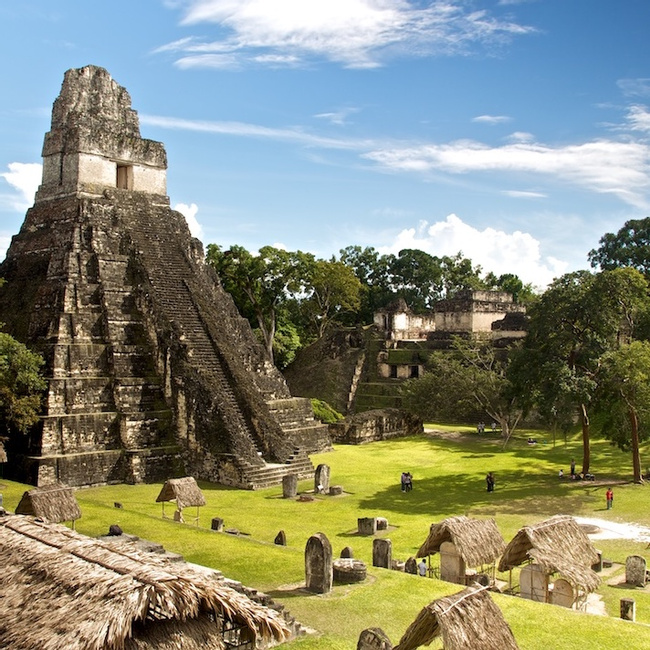- Travel Guides
Guatemala's Government and Economy
Guatemala has a stable democratically elected government, but one that is not without its fair share of corruption and clandestine power. That said, today’s democracy is a huge step forward from the military-oligarchy alliance that dominated Guatemala for much of the 20th century. The Guatemalan economy is the largest in Central America, and is dominated by the private sector.

Guatemala has a long and varied history; unsurprisingly, this has influenced both the government and ethnic diversity. The nation maintains a very strong cultural identity, which is even reflected in the name of their currency—the quetzal...a bird which was sacred to the Mayans.
Government
Suffrage is universal for everyone over 18, though, due to the country's history of military dictatorships, police and active members of the armed forces are not allowed to participate.
Guatemala is a constitutional democracy. Both the president and vice president are elected to office to serve a single four-year term. The president cannot run for a second term, but the vice president can run for president after taking a four-year break from office. The Congreso de la República is the national legislative body, with congress members serving four-year terms concurrently with the president.
The judicial branch is independent of the legislative and executive branches and includes both a Constitutional Court and a Supreme Court of Justice. The Constitutional Court is the most powerful court in Guatemala and has five judges that are elected for five-year terms. The general public tends to view the judicial branch with suspicion, thinking it corrupt and widely inept.
The history of Guatemala’s government has been anything but smooth. From 1954 to 1986 the country was ruled by a military-oligarchy alliance. Presidents were installed repeatedly by military coups or sham elections. After the very few elections that were considered fair, the military quickly took control and the president remained a mere figurehead. The elections since 1986 have been considered fair, but the military continues to hold substantial power. Guatemala’s democratic process has slowly given more power to the state while limiting the power of the military.
While the country is definitely on a more free and democratically legitimate trajectory, there is still substantial work to do before a genuine functioning democracy exists in Guatemala. Both the legislative and judicial branches are thought to be widely ineffective and corrupt, controlled by members who yield substantial power behind the scenes and operate outside the law. Some Guatemalan citizens have even sought legal proceedings in international courts.
The general pattern over the last 30 years has been one of high expectations for change prior to an election. After an election, the new government has often failed to keep its election promises, and the people become disappointed and frustrated. Renewed hope for the next elections gains steam and the process repeats itself. Time will tell whether legitimate, authentic leaders will be able to break this pattern.
Economy
The Guatemalan economy is robust, and is actually the largest economy in Central America. Guatemala’s GDP in 2013 was $81.5 billion, up from $78.9 in the previous year. The GDP per capita was $5,300 and the inflation rate was about 4.4 percent for the same year. Guatemala is the largest economy in Central America and also the most populous country in the region. Even so, many members of Guatemala remain minimally active in the economy and live in poverty.
Agriculture accounts for 13.5 percent of the Guatemalan GDP and employs 38 percent of the population. The primary exports include coffee, bananas, sugar, cardamom, timber, rice, rubber, flowers, vegetables, and plants. Industry contributes about 24 percent of the GDP and manufactures textiles, pharmaceuticals, tires, clothing, prepared food, and construction materials. Industry employs about 14 percent of the population. The service sector is the largest sector of the Guatemalan economy, making up 62 percent of Guatemala’s GDP. The service sector is the largest employer (partially thanks to tourism), with around 48 percent of the population employed by this sector.
The private sector generates around 85 percent of GDP. The government involvement in the economy is fairly small — its business activities are limited to public utilities, the operation of airports and ports, and a few financial institutions. Foreign investment in Guatemala has remained fairly weak. Potential investors cite government corruption as a deterrent.
Tourism has had a large impact on the Guatemalan economy since 1996. According to government statistics, some 1.7 million visitors came to Guatemala in 2013, up from 826,000 in 2000. Of the Central American countries, only Costa Rica receives more visitors. Around 30 percent of Guatemala’s visitors come from North America, 18 percent come from Europe, and another 18 percent come from other countries.
Tourism is a powerful force for strengthening local communicates and economies, and many towns have built a sound tourism infrastructure. The government is promoting tourism abroad and making improvements to the country’s airports. The government is also working to make travel as safe as possible for visitors, and installs tourism police in main tourism destinations.
Guatemala has a wide wealth gap, meaning you will see poverty at some point during your trip. The richest 10 percent of the population earns one-half of all income, while the top 20 percent earns two-thirds. Meanwhile, around 80 percent of the population lives in poverty. Most of those people live on less than $2 a day.
We believe travel is more than ticking destinations off a list – it’s about discovering new places deeply, feeling connected wherever you go, and knowing you have a trusted team behind you every step of the way.



